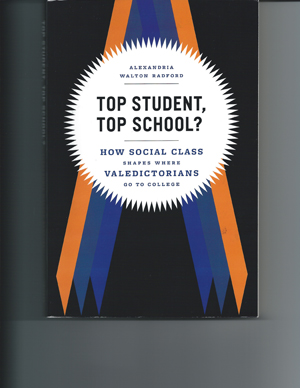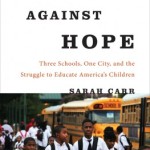Failure To Apply: A New Book Charts Why Poor Kids Forgo Top Colleges
By Paul Glader on April 16, 2014
Domestic, Minorities, Parents, Required, Universities & Colleges
Only 3 percent of students at the nation’s 146 most selective colleges and universities are from the bottom 25 percent of the income scale. And Radford says it’s not necessarily because they’re less academically well prepared than students at the top.
She surveyed 900 valedictorians at all socioeconomic levels, and found that those from low-income families had parents who were not as involved in helping them apply to college as their high-income counterparts. Low-income parents also emphasized cost more, and were more likely to encourage their children to stay close to home.
“’You’re just going to go where we can afford to send you,’” one low-income valedictorian said her parents told her. “I … had to get a scholarship if I wanted to go somewhere else.”
The public high schools most of these students attended were described as equally unhelpful, with guidance counselors characterized as uninformed—and, by the students themselves, as “pretty lousy” and “incompetent.”
At best, the counselors are overworked. The ratio of counselors to students at public high schools is 1 to 285, and of college counselors to students, 1 to 338. Only one in four public high schools even has at least one full-time college counselor, compared to three out of four private ones.
Nor did less-affluent valedictorians find easy access to information about financial aid. Only 28 percent of parents of students in the lowest income brackets had a good understanding of financial aid, compared to nearly 60 percent of high-income parents, and low-income students also were unlikely to receive accurate or comprehensive information about it from their high schools.
“All I knew is that I asked my dad about it and he’s like, ‘No, we don’t want to take any financial aid,’” one student said. “I guess it’s like a pride thing for him. So I didn’t really look into it.”
The student-loan provider Sallie Mae reported in 2011 that 13 percent of families with annual incomes under $35,000 did not apply for financial aid.
So while more than half of top SAT and ACT scorers from the upper-income category enroll in top institutions, only a third of low-income standouts do. Three-fourths of high-income valedictorians end up enrolling at the nation’s most-selective colleges, compared to 43 percent of low-income ones.
This lopsided ratio comes despite the fact that, when they do apply, low-income students (also described as those with low socioeconomic status, or SES) are more likely to be admitted than high-income applicants. Sixty-three percent are accepted to the most selective institutions, compared to 50 percent of their middle-class peers and 54 percent of wealthy students.
“Given the greater socioeconomic hurdles less-affluent students face, admissions officers may be more impressed when low-SES students reach the top of their class than when middle- or high-SES students manage to do so,” Radford writes.
The book, Top Student, Top School: How Social Class Shapes Where Valedictorians Go to College, is published by the University of Chicago Press.
In it, Radford urges more publicity about need-based aid, better explanations of net price versus sticker price, and better high school counseling.
“Many of our best and brightest students, who deserve to attend our nation’s best colleges and would thrive at them, are prevented from doing so because of their social class origins,” she says.
The information universities and colleges are now providing, Radford writes, is not particularly helpful.
Glossy promotional mailings, for example, don’t sway top students. Many said they never even read them.
“I mean, I haven’t heard of anybody really saying, ‘Oh, I got a letter in the mail from College X and that made me go there,’” one student said.
This post was produced by The Hechinger Report, a non-profit journalism organization housed at Columbia University in New York City.
Related Posts


Tips & Pitches
Latest WA Features
-
Online Courses Are Expanding, Along With Questions About Who Owns The Material
-
Why Size Matters: Consolidation Sweeps Across US Higher Ed
-
Trend: Corporate U Employers Offering Just In Time Education To Workers
-
Subterfuge & Skullduggery In The College Rankings Game
-
“Instreamia” Shakes Loose Moss By Launching Spanish Language Mini-MOOC
Domestic, Education Quality, For-Profit, Friend, Fraud, or Fishy, K-12, Legislation, Opinion, Personalized Learning, Regulatory, Required, Universities & Colleges - Apr 29, 2014 - 0 Comments
Michael Horn: NCAA March Madness Followed By April Blunder In Online Learning
More In For-Profit
- The Economy Is Forcing Tuition To Fall Rapidly At Private, For-Profit Colleges
- Kamenetz: Jeb Bush As Controversial Leader Of Aspen Task Force on Learning & The Internet
- Columnist Ryan Craig: The Best Of Times Could Return As For-Profit Edu Invests
- Bubble Analysis: Trace Urdan on Why This Era of Ed Investing Could Be Different
- A Blended Path? How American Honors Cuts Cost of Four Year Degree by Over a Third
Community Colleges Cost of Education Domestic For-Profit Required Student Loans Universities & Colleges
Cost of Education, Domestic, Education Quality, Friend, Fraud, or Fishy, Opinion, Personalized Learning, Required, Technology, Universities & Colleges - Jan 17, 2014 - 0 Comments
Online Education As A Postmodern Societal Response
More In Technology
- MakerBot Academy: A 3-D Printer In Every Classroom
- Michael Horn: A Look Behind The Curtain At How A MOOC Is Made
- Koller, Khan and Agarwal At The NYT’s Schools of Tomorrow Conference
- Video: New NESTA Report, Three Steps To Assess Digital Innovation in Education
- Norwegian Teens Publish Their Own Guide To Teaching and Learning In Web 2.0
Blended Learning Education Quality International K-12 Open Source Education Personalized Learning Required Technology
Domestic, Education Quality, For-Profit, Friend, Fraud, or Fishy, K-12, Legislation, Opinion, Personalized Learning, Regulatory, Required, Universities & Colleges - Apr 29, 2014 - 0 Comments
Michael Horn: NCAA March Madness Followed By April Blunder In Online Learning
More In Friend, Fraud, or Fishy
- Online Education As A Postmodern Societal Response
- Apple Tightens Its 94% Choke-hold On The Education Tablet Market
- Michael Horn: Why Obama’s Proposals Won’t Entirely Revolutionize HigherEd
- Columnist Ryan Craig: The Curious Case Of HigherEd Accreditation
- McGraw-Hill Executive Speaking About Big Data: “Don’t look at us, look at Joe Camel”
Domestic Ebooks Education Quality Ereaders Ethics Friend, Fraud, or Fishy K-12 Publishers & Curriculum Required Textbooks











Reply